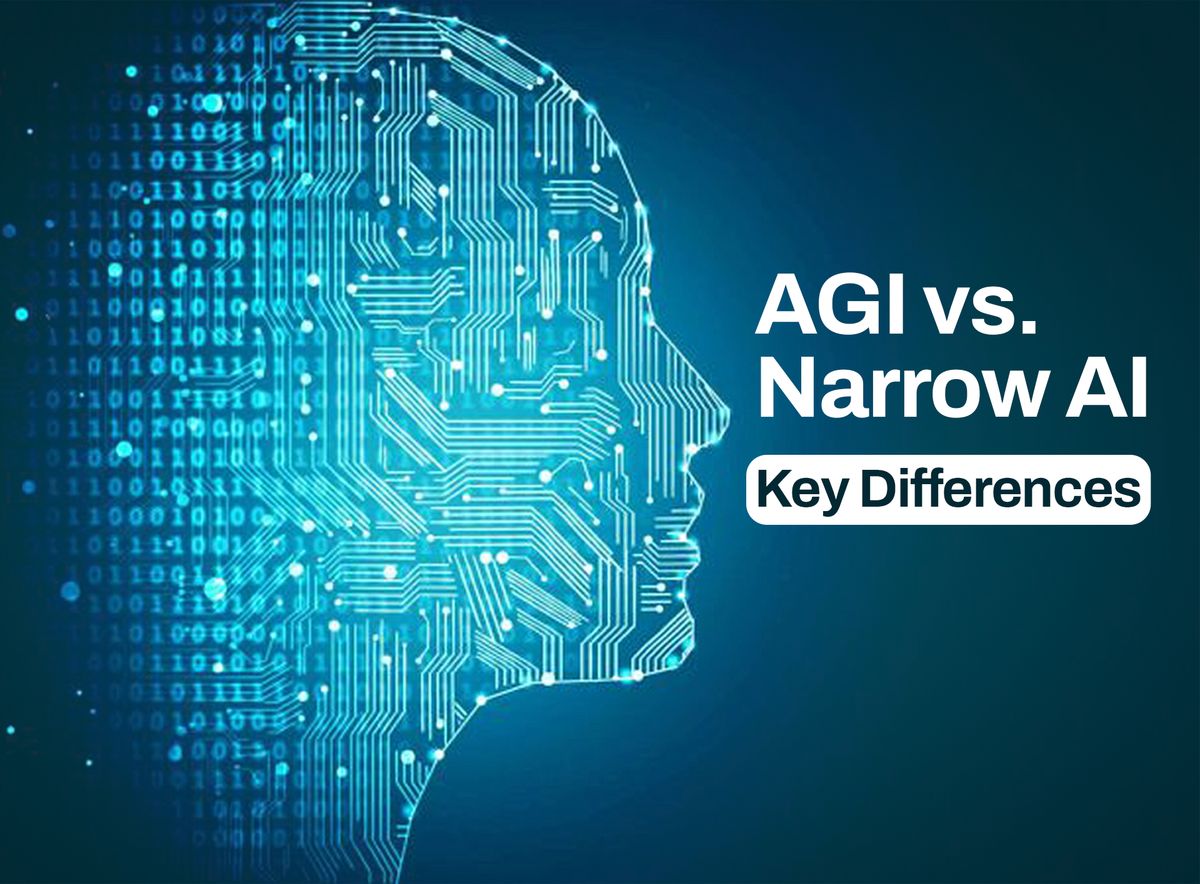AGI vs. Narrow AI: Understanding the Key Differences
Narrow AI is designed for specific tasks, while AGI aims to perform any intellectual task that a human can do.

Table of Contents
- What is AI?
- Types of AI
- What is Narrow AI?
- What is Artificial General Intelligence?
- Key Differences Between Narrow AI and General AI
- Future of AI: Is AGI Achievable?
- Takeaway
- FAQs
Is AI becoming the new pathway for technological advancements? Or is it just a tech trend that will soon vanish as newer technologies emerge? Is AI going to overthrow humans and take their jobs? Can AI even function without any human input or control?
These and many more are the questions that have arisen since AI (Artificial Intelligence) was incorporated into different fields—fintech, healthcare, transportation, banking, retail, e-commerce, communications, and media, to mention a few.
Since AI became a “thing”, there have been different variations that have received praise and brutal criticism. For instance, the AI behind facial recognition has been strongly criticised over the years for promoting racial bias, while others like ChatGPt have been praised for their productive accuracy.
This discrepancy in reception might be based on the categories of AI that these models belong to and the level of their capabilities. Some of them might be General AI (although there are no records of a functional model in operation), and the others Narrow AI.
So, to break the ice, let’s explore what AI is, the types of AI, and how they differ from each other.
What is AI?
Artificial Intelligence (AI) refers to machines or software designed to perform tasks that typically require human intelligence. These tasks can include learning, reasoning, problem-solving, understanding language, and recognising patterns.
AI can be traced back to the 1950s when the first concepts of creating intelligent machines were introduced. The first AI program, written in 1951, was a checkers-playing program created by Christopher Strachey, a British computer scientist. Since then, AI has evolved significantly and can be seen in various industries today.
Types of AI
Artificial Intelligence (AI) can be divided into three main types: Narrow AI, General AI, and Superintelligent AI.
Narrow AI, also known as Artificial Narrow Intelligence (ANI), is designed to perform a specific task, such as voice recognition or playing chess. For instance, Apple's Siri or Google's search algorithms are examples of artificial narrow intelligence.
General AI, or Artificial General Intelligence (AGI), refers to machines that possess human-level intelligence and can perform any intellectual task that a human can do. This type of AI is still theoretical and is the focus of much research and debate.
Superintelligent AI surpasses human intelligence and is smarter than the best human brains in practically every field, including scientific creativity, general wisdom, and social skills.
However, for the purpose of this article, we will focus on exploring AGI and Narrow AI. What is Narrow AI and General AI?
What is Narrow AI?
Narrow AI, also known as Artificial Narrow Intelligence (ANI) or Weak AI, refers to AI systems designed to perform specific tasks. Unlike Artificial General Intelligence (AGI), which aims to mimic human-level intelligence across a wide range of activities, narrow AI is limited to particular functions. For example, a chatbot that answers customer service questions or a recommendation system that suggests movies based on your viewing history are examples of artificial narrow intelligence. These systems perform outstandingly in their specific roles but cannot operate outside their predefined tasks.
Current AI technologies like virtual assistants (e.g., Siri and Alexa) and recommendation algorithms are clear examples of artificial narrow intelligence. Another example of artificial narrow intelligence is a chess-playing computer that excels at chess but can't perform other tasks. These tools are highly effective within their specific domains but lack the adaptability and comprehension of AGI models.
What is Artificial General Intelligence?
Artificial General Intelligence (AGI), also known as General AI, human-level intelligence, or Strong AI, refers to a type of AI that can understand, learn, and apply knowledge across a wide range of tasks, similar to a human being.
This means AGI can perform any intellectual task that a human being can. One example of artificial general intelligence would be a robot that can not only play chess but also cook a meal, understand a new language, and solve complex scientific problems without needing additional programming for each new task.
AGI models are designed to mimic the cognitive abilities of humans, making them capable of reasoning, problem-solving, and learning from experience in a way that narrow AI cannot. Currently, there are no existing examples of artificial general intelligence as it is still a theoretical concept, but researchers are working towards creating AGI models.
Key Differences Between Narrow AI and General AI
Here's a table to illustrate the differences between both AIs:
Future of AI: Is AGI Achievable?
Despite significant progress in AI research and the several projects and research efforts pushing towards this goal, creating AGI is still a distant goal. One notable project is OpenAI's research into AGI models. OpenAI has been developing increasingly advanced AI systems, like GPT-4, which show progress in general reasoning but are still considered Narrow AI because they lack the broad understanding and adaptability characteristic of AGI.
Another effort is DeepMind's work on artificial general intelligence, where they are exploring ways to create AI that can spread across different types of tasks and environments, though they have not yet achieved true AGI. Despite these advancements, there are major obstacles to overcome, such as creating machines with genuine understanding and self-awareness, not just advanced pattern recognition.
Currently, experts are divided on whether AGI will be achieved soon. Some predict it could be decades away due to these complex challenges, while others are optimistic that breakthroughs in AI research might speed up the timeline to the mid-21st century.
Though there are many ambitious projects on AGI in progress, the road to creating a truly intelligent and adaptable machine is still long and filled with challenges.
Takeaway
There’s a lot to takeaway from this article, but the major information is that there is no definite time to anticipate the perfection and usage of AGI yet. However, one thing is certain — all the AI systems that the public currently has access to are basically categorised under artificial narrow intelligence.
Despite this, it is important to appreciate the current variations of AI because they are paving the way for advancements towards artificial general intelligence and its potential to revolutionise our interaction with technology.
FAQs
Q1. What is the main difference between Narrow AI and AGI?
Narrow AI is designed for specific tasks, while AGI aims to perform any intellectual task that a human can do.
Q2. Can Narrow AI learn new tasks?
No, Narrow AI is limited to its programmed functions and cannot learn new tasks on its own.
Q3. Is AGI currently available?
No, AGI is still under research and development and does not yet exist.
Q4. What is an example of Artificial Narrow Intelligence?
Virtual assistants like Siri and Alexa are examples of Narrow AI.
Q5. What is an example of Artificial General Intelligence?
A5. As of now, there are no true examples of AGI. But a possible model is a robot or machine that can independently perform tasks like cooking, managing kids, and so on.
Q6. What is the goal of AGI?
The goal of AGI is to create machines with human-level intelligence that can perform any intellectual task a human can.
Q7. How does Narrow AI impact our daily lives?
Narrow AI is used in various applications like recommendation systems, image recognition, and digital assistants.
Q8. What is human-level intelligence?
Human-level intelligence refers to the ability to understand, learn, and apply knowledge in different situations, similar to how humans think and reason.
Q9. What are AGI models?
AGI models are theoretical frameworks aiming to achieve human-level intelligence in machines.
Q10. What is the future of AI?
The future of AI involves advancing current technologies and working towards achieving AGI, which would bring machines closer to human-like intelligence.
Disclaimer: This article was written to provide guidance and understanding. It is not an exhaustive article and should not be taken as financial advice. Obiex will not be held liable for your investment decisions.




